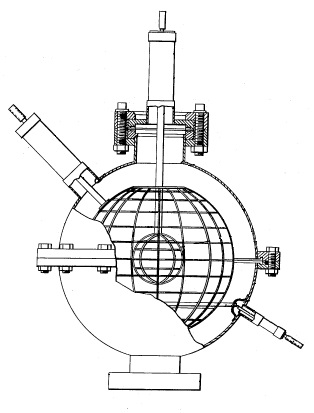In 1965, Lawrence Livermore Laboratories worked on a 12-beam "4 pi laser" with a twenty centimeter gas filled chamber. They had been working on the theory of "inertial confinement fusion" (ICF) during the 1950s. The basic idea of ICF is to initiate fusion in a pellet of 2H (deuterium) and 3H (tritium) by heating and compression. Lasers are used create a spherical configuration of laser beams to heat the surface of the pellet so that it explodes. The explosion produces a burst of x-rays which compresses and heats the inner part of the pellet to the point where fusion occurs. The pellets are about the size of a pin head and contain about ten milligrams of fuel. Only a small portion of the fuel actually fuses but a significant amount of energy is released.
In 1967, a fusor was demonstrated that produced neutrons which indicate a fusion reaction. The fusor was the work of Philo T. Farnsworth, an American inventor and Robert L. Hirsch a senior energy program advisor. In a fusor, ions are injected into a chamber where a high voltage potential accelerates the ions. Oscillating magnetic fields help confine the ions to the center of the chamber. If the voltage potential is high enough, the ions can be made to fuse. Farnsworth referred to this as inertial electrostatic confinement.
In 1968, the Soviet scientists reported on their work with the tokomak design. They reports temperatures in their devices which were ten times what the global fusion research community expected. Scientists from other countries visited the Soviet Union and verified the high temperatures. This ignited new interest in magnetic confinement and the tokamak remains the main research tool for this type of fusion to the present day. Friedwardt Winterberg proposed bombarding a 2H-3H pellet with relativistic electrons from a Marx generator. The Marx generator was designed by Erwin Otto Marx in 1924. This type of generator produces a very high voltage pulse from a low voltage DC power supply.
In 1972, Lawrence Livermore National Laboratories created the first neodymium-doped glass laser intended for inertial confinement fusion research. This powerful infrared laser was called the Long Path laser. It was able to deliver fifty joules of infrared light in a ten nanosecond pulse to the target. Because it did not use special optical devices called spatial filters to smooth the beam after amplification, the beam it produces was of low quality.
In 1973, design work was started on the Joint European Torus (JET) for magnetic confinement research at Oxfordshire, U.K. The construction of the buildings, the tokamak type fusion device and the power supply for the JET occupied about a decade. Two onsite generators are needed to supply power to the toroidal and poloidal coils because the U.K. electrical grid cannot supply the current needed.
Diagram from a U.S. patent for a fusor:
